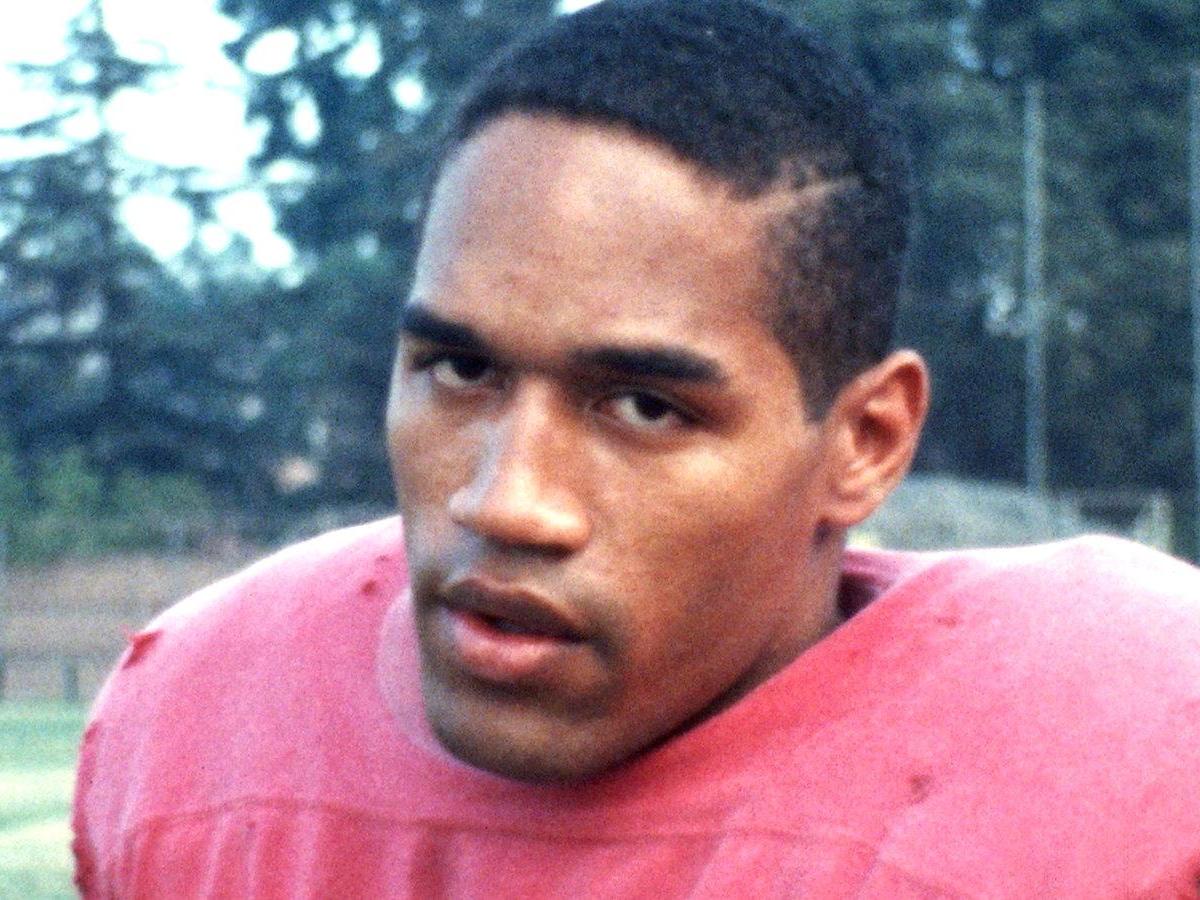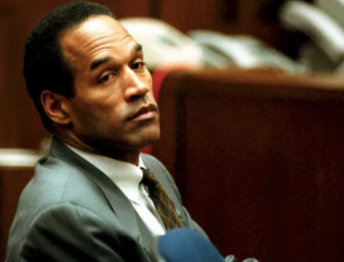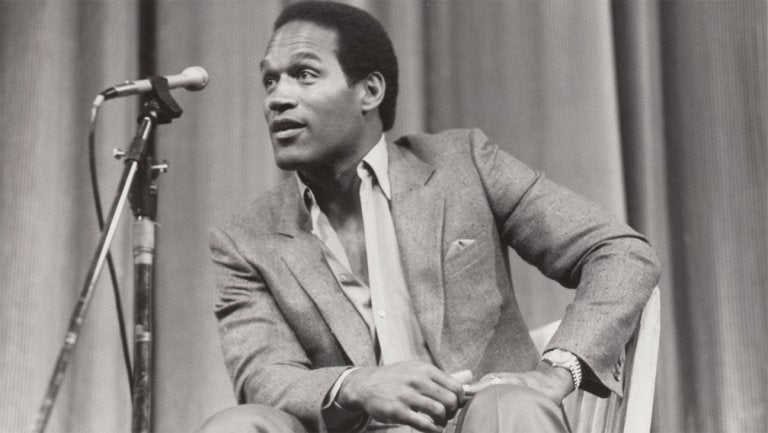My favourite sports documentary – OJ: Made in America
Continuing the series of films chosen by our sports writers is this five-part dissection of the OJ Simpson murder case. For our Senior Football Correspondent, Melissa Reddy, growing up in South Africa, the way the case turned on race brought it close to home in a way that only Ezra Edelman's documentary has explored


On 17 June 1994, just over a month after Nelson Mandela’s inauguration as South Africa’s first black and democratically elected president, there was a break in transmission about the new “rainbow nation” to screen a live slow-speed chase happening on the Los Angeles freeways.
Lying on the carpet in the lounge at my great grandmother’s house in Durban, I didn’t immediately understand why this footage from abroad was given so much airtime.
OJ Simpson, one of the greatest-ever running backs in American football history turned A-lister, was being trailed by a sea of police cars as he sat in the back seat of his white Ford Bronco SUV with a gun to his head, as it was driven by a long-time friend.
Who? What?
For a South African kid who was still a way off reaching double digits in age, this story felt so distant.
As the bulletin continued, it detailed that the 46-year-old NFL Hall of Famer was charged with the double homicide of his ex-wife Nicole Brown Simpson and her friend Ronald Goldman.
The scale of the news quickly became clear and so too would the sub-plot that defined it.
OJ was famous and black, the victims were white. I may not have been able to point out LA on a map, but I could tell when anything – in this case a tragic loss of two innocent lives – would become framed by race.
It was impossible to be born into Apartheid South Africa and not view life through such a black-and-white lens. My existence was dictated solely by my skin colour: where I lived, where I went to school, the places I was allowed to go…
I sat up off the carpet and moved closer to the small television set nestled in the large wooden cabinet, digesting every word.
This would later become my routine when I returned home from school to watch the “trial of the century”, which began in January 1995.
I had notebooks full of information I had jotted down, complete with newspaper and magazine clippings. One cover screamed “101 Reasons Why OJ Did It”, which was the title of the play I scripted for the final group project in English class that year.
My team corrected the wrongs of the real-life prosecution, led by Marcia Clarke, who failed to grasp just how mammoth a factor race would be in determining the outcome of proceedings.
That reality, despite being overwhelmingly obvious, had never been examined in layered detail until Ezra Edelman’s OJ: Made in America.
Currently streaming on BBC iPlayer and ESPN Player, the five-part documentary tells the tale everyone knows, and tells it better than anyone has ever done – with a more panoramic focus.
It superbly explores how decades of turmoil between black and white LA ultimately collided in the County’s Superior Court for nine months.
In a captivating seven hours and 43 minutes, Edelman lays bare the disconnect between the communities, painting a high-definition picture of discrimination and the distrust of law enforcement, which was crucial to OJ’s trial.
He stretches back to the 1965 Watts Riots, the assassinations of Martin Luther King Jr and Robert Kennedy three years later and revisits the 1979 shooting death of Eula Love by police that was precipitated by an overdue gas bill.

The spotlight shifts to the killing of 15-year-old Latasha Harlins in 1991 by a Korean shop owner, which happened 13 days after the savage battering of Rodney King by Los Angeles police. Footage of the latter, which was recorded by a civilian from his balcony, is shown in full during the documentary.
“You needed to emotionally connect with what was happening, with the struggles of black people in this city — in general, every day, also at the hands of the police,” Edelman told film critic Elvis Mitchell.
“It couldn’t be: ‘A happened, then B happened, then C happened.’ It’s not intellectual, it’s emotional.”
It is during episode four that Made in America acts as a thumbnail of LA’s racial history. It’s why, despite Clarke saying despite having more evidence against OJ than she can remember seeing during her professional career, it was the prosecution, not the former football star, that was doomed.
The LAPD’s decades of mistreatment of the city’s black community ensured that it was they who were on trial.
The misgivings about the police force only deepened when officer Mark Fuhrman – who retrieved the infamous bloody glove from the scene of the killings, which matched one taken from OJ’s home – was proven to have repeatedly used racial slurs.
As Edelman explained in the LA Times: “A lot of it is personal, and it wasn’t necessarily intellectual in terms of parsing the evidence in the case. It’s emotional in terms of having gone through those experiences personally, and/or having family members or friends who have been victims of police injustice in some form.
“You’re obviously going to project that onto what is the most high-profile African American defendant, certainly in a murder trial, in American history.”
It didn’t matter that Simpson, as is surgically demonstrated throughout the 467 minutes, was the furthest candidate to be a poster boy for civil rights.
From his “I’m not black, I’m OJ” declaration to arriving home and asking “what are all these n***** doing in Brentwood?” when African-Americans flooded his affluent neighbourhood as a show of support upon his arrest, Simpson was no Muhammad Ali.
“The defining cultural story of the last half century in the US”, as Edelman put it, is fascinating as it illustrates how the people the defendant most tried to delete from his life ended up embracing and saving him.

“He was seduced by white society,” says childhood friend Joe Bell, one of 65 people to speak on screen during the documentary. “He lost his identity; he didn’t know who he was.”
OJ’s defence team, headed up by Johnnie Cochran, made sure the majority black jury connected with their client, going so far as to manipulate the framed pictures in Simpson’s home before their visit during court proceedings.
One of the jurors, Carrie Bess, is asked if she regrets her decision to acquit Simpson back then. “Somewhat,” she says. “But deep in my heart I done what I felt was right. Back then, we took care of our own.”
While race is the overarching narrative of Made in America, Edelman also unboxes themes of sports, celebrity, fame and abuse, and views the many aspects of Simpson the man.
He was the record-breaker whose 2000 yards in a 14-game season for the Buffalo Bills has never been replicated. He was “the Juice”, who in 1977 was listed as the most popular person in the US. He was the face of car-rental giant Hertz and the first black endorser on TV to be effective with white consumers. He was the domestic abuser. The cheater at golf. The film star. The man accused of a terribly vicious double homicide.
There are especially gripping moments throughout the Oscar-winning epic, such as OJ’s former manager Mike Gilbert revealing he told his client that not taking his arthritis medicine would make his hands swell before the famous “if it doesn’t fit, you must acquit” glove scene.
The more I watched, the more I realised Made in America isn’t really about the man in the dock. It’s about us. It’s about society, culture, experiences and the different contexts through which we view the same things.
It is why 26 years after the story first resonated with me, it still connects on such an intimate level.
Join our commenting forum
Join thought-provoking conversations, follow other Independent readers and see their replies
0Comments